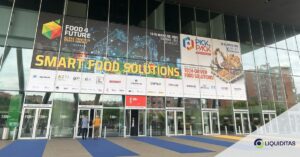There’s something telling about a food conference that smells like innovation. Not literally, of course. Bilbao’s air was filled with the usual roasted coffee and tapas, but the atmosphere inside Food 4 Future was unmistakable: possibility, pressure, and progress, all at once.
From the main floor to the break-out panels, one thing was clear, this industry isn’t waiting around.
The Push Is Coming From All Sides
Consumer expectations are no longer polite suggestions. They’re demands. Transparency, traceability, sustainability. Labels don’t just inform anymore; they must reassure. People want to know what’s in their food, where it came from, how it was made, and whether it left a carbon footprint larger than a dinner plate.
This alone would be enough to force a rethink. But it’s not just consumers.
Regulations are tightening across Europe. Sustainability targets are becoming more specific and less avoidable. Several of the food producers we spoke with in Bilbao aren’t just preparing ESG reports because they want to, but they’re doing it because their buyers are already setting the bar higher than the regulators.
And it’s not stopping at CO₂. Water usage, energy inputs, packaging recyclability, ingredient sourcing, all of it is up for scrutiny.
Automation Is Moving Off the Whiteboard
Walking through the expo hall, you couldn’t help but notice how fast automation is moving from idea to reality. What used to be a conversation about “future potential” has become a showcase of production-line-ready robotics and intelligent inspection systems.
We’re talking about precision-controlled vertical farms, robotic harvesters that don’t bruise produce, and real-time sorting lines powered by machine vision. One startup showed off an autonomous mobile unit designed to track freshness through temperature and vibration sensitivity during transport. Another was demoing an AI-powered dashboard that predicts line slowdowns before they happen, like preventative maintenance for your entire plant.
But while the tools are impressive, the bigger challenge is integration.
We heard this again and again in side conversations: It’s not just about buying new tech. It’s about making it work across your fragmented supplier network. It’s about onboarding your teams, aligning your data streams, and creating a system where everything from production to payment actually talks to each other.
From Farm to Fork – And Back Again
What stood out most wasn’t any single booth or pitch. It was the shift in mindset.
The idea of a self-contained operation, “We grow, we make, we sell,” is fading fast. More companies are leaning into partnerships. Collaboration became a business strategy.
The new wave of food innovation is defined by its interconnectedness. Supply chain coordination has slowly become existential.
One panelist summed it up better than most: “If your sustainability goals stop at your factory doors, they’re not goals. They’re PR.” That landed.
The forward-thinkers in Bilbao are designing systems where producers and suppliers share data, buyers and farmers negotiate on shared timelines, and everyone in the chain has a financial stake in making better decisions.
This is where platforms like Liquiditas can play a real role: removing the friction in the flow of capital that slows collaboration down. Faster payments, better financing terms, and visibility on who needs what, when, and why, are quietly becoming the hidden engine behind more sustainable, resilient systems.

Do you find this article interesting?
Subscribe to our Newsletter for updates on the latest blog articles.
Startups: Hungry, Smart, and Fundraising
Another big takeaway: the startup ecosystem is buzzing, but with sharper focus than we’ve seen in years past.
Gone is the era of vague innovation for its own sake. The new batch of food-tech companies is pragmatic. They’re thinking about margins, market fit, and scale from day one.
You could feel it in the conversations around funding. Investors aren’t just looking for the next “plant-based” boom, they’re looking for the tools that support infrastructure, enable digitization, and improve cost-efficiency without compromising sustainability.
Product-market fit was everywhere. Whether it was a fermentation-based protein startup that’s already partnering with regional distributors, or a traceability platform with built-in compliance features, these are businesses built with exits and real-world adoption in mind.
And for all the talk of moonshots, there was an honest reckoning happening: scaling sustainably means playing a long game. It’s not just about being first to market. It’s about building relationships that turn trials into contracts, and pilots into pipelines.
What This Means for the Rest of Us
The food and beverage industry is evolving, but not evenly.
The companies that are winning aren’t just adopting new tools. They’re redesigning their operating models. That includes rethinking how and when payments are made, how they work with suppliers, and how to turn finance from a constraint into a lever.
Here’s the real field note: finance is becoming part of the sustainability toolkit.
If your supplier can’t afford to wait 90 days to get paid, your ESG plans won’t hold. If your innovation timeline is delayed because your partners don’t have the liquidity to scale with you, the opportunity passes.
Liquidity isn’t just an internal metric anymore. It’s a shared challenge and an enabler.
Final Thought from the Floor
Bilbao didn’t feel like a trade show. It felt like a pulse check.
The message from the industry was loud and clear: we’re ready to move faster, cleaner, and smarter, but only if the system around us moves too.
That’s where collaboration wins. That’s where solutions like Liquiditas turn out to be the lever for progress.
You can’t talk about the future of food without talking about the mechanics that get it there.
And we’re here to keep that conversation moving.






